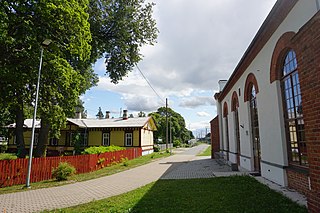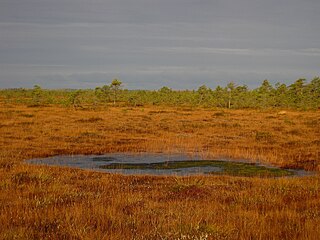
Lahemaa National Park is a park in northern Estonia, 70 kilometers east from the capital Tallinn. The Gulf of Finland is to the north of the park and the Tallinn-Narva highway (E20) to the south. Its area covers 747 km2. It was the first area to be designated a national park of the former Soviet Union. It is the largest park in Estonia and one of Europe's biggest national parks. Its charter calls for the preservation, research and promotion of North-Estonian landscapes, ecosystems, biodiversity and national heritage.

Aegviidu is a borough in Anija Parish, Harju County, Estonia, most known for its picturesque surroundings and hiking trails.

Anija Parish is a rural municipality in the eastern part of Harju County, Estonia.

Kuusalu Parish is a rural municipality in northern Estonia, the largest in Harju County. After joining with the adjacent Loksa Parish in 2005, the municipality has now a population of 6,863 and covers an area of 707.97 km2 (273.35 sq mi). The population density is 9.7 inhabitants per km2.

Nigula Nature Reserve is a nature reserve situated in South-West of Estonia, in Häädemeeste and Saarde parishes of Pärnu County. It has an area of 63.98 km². Nigula nature reserve is one of the oldest bog reserves in Estonia. It is established to protect the Nigula Bog and its surrounding forests in their natural state.

Põhja-Kõrvemaa Nature Reserve is a protected area in Harju County, Northern Estonia, some 50 km east of Tallinn. With an area of 130.9 km2, it is the third largest nature reserve in Estonia. Dominated by forests and bogs, it aims to protect rare and endangered species, their habitats, and valuable natural landscapes.

Alam-Pedja Nature Reserve is the largest nature reserve in Estonia. It is a vast wilderness area which covers 342 km2 and consists of a complex of 5 large bogs separated by unregulated rivers, their floodplains, and extensive forests. The nature reserve aims to protect diverse ecosystems and rare species, mainly through preserving the natural development of forests and bogs and securing the continuing management of semi-natural floodplain grasslands.
Nätsi-Võlla Nature Reserve is a nature reserve situated in western Estonia, in Pärnu County, made up of several bogs that together form the largest bog area in Pärnu County.

Endla Nature Reserve is a nature reserve situated in central Estonia.

Agusalu Nature Reserve is a nature reserve situated in eastern Estonia, in Ida-Viru County.

Muraka Nature Reserve is a nature reserve situated in eastern Estonia, in Ida-Viru County.
Sookuninga Nature Reserve is a nature reserve situated in south-western Estonia, in Pärnu County.

Rubina Nature Reserve is a nature reserve in Viljandi County in southern Estonia.

The Tarvasjõgi is a river in Estonia. It is also called the Mõnuvere. It is a tributary of the Jäneda, which in turn flows into the Jägala and thence into the Baltic Sea. The Tarvasjõgi begins near the Piibe Highway. The river is 30 kilometres (19 mi) long and has a 64.7-square-kilometre (25.0 sq mi) drainage basin.

Kakerdaja Bog is a bog in Järva County, Estonia. This bog is part of Epu-Kakerdi Wetland Massive.

Suru Suursoo is a bog in Harju County, Estonia. The bog is part of Põhja-Kõrvemaa Nature Reserve.
Puhatu Wetland Complex is a bog in Ida-Viru County, Estonia. The bog extends from northern bank of Lake Peipus to Auvere-Narva line. It is part of Estonia's largest mire system Agusalu-Puhatu. The complex is protected.

Muraka Bog is a bog in Ida-Viru County, Estonia.
Kõrvemaa is a geographical region in Northern Estonia. Its area is 3,132 km2 (1,209 sq mi), with length of 110 km (68 mi) and width of 40 km (25 mi).














